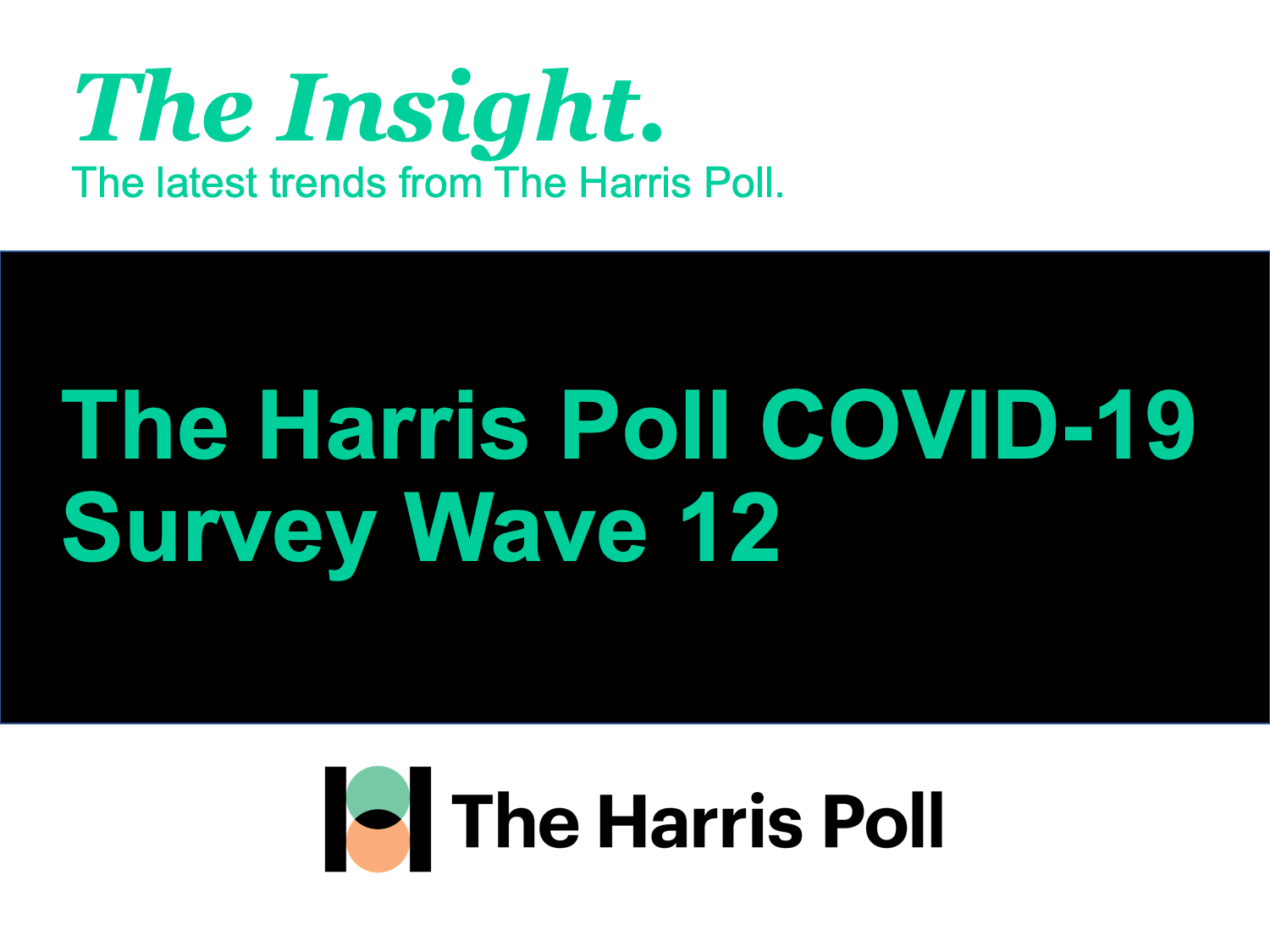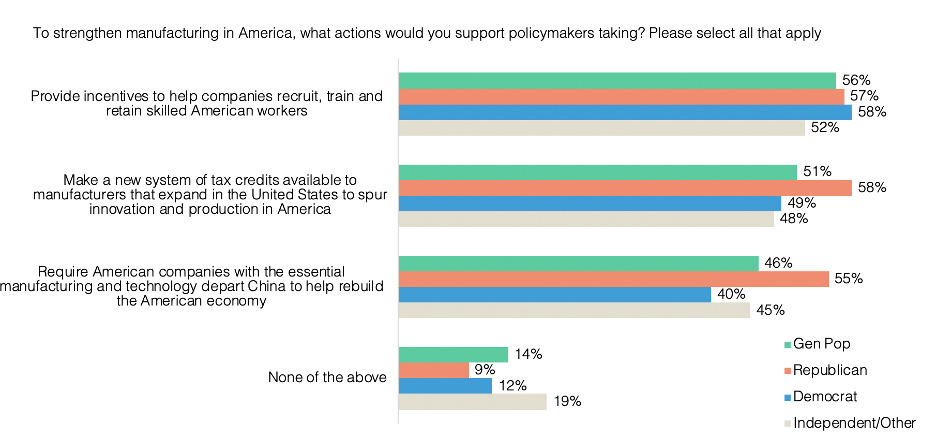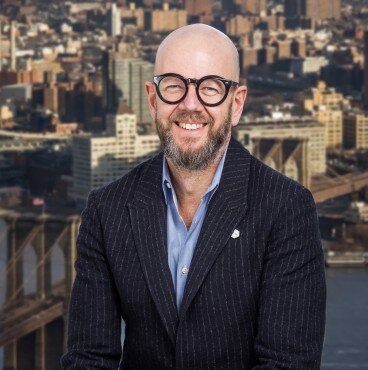Brief • 4 min Read

In Wave 12 of The Harris Poll Cv19 Tracker fielded May 15 to 17, 2020, states are reopening, bringing with it new tensions. Two of our major stories this week are polling that shows the deepening political fissures between economic and public health and a surprising schism between generations. Call it the canes vs. the scooters.
We also look back a decade to a Harris study asking (then and now) what does it mean to be American? Also, the promise for tech health has had some fits and starts, but might this be its golden age? Americans are all-in to be good patients and help solve the biggest healthcare crisis in our lifetime. Lastly, we asked Americans how are we likely to remember Cv19? (or will we just want to forget)? Finally, for more takes on voter sentiment, read the latest Harvard CAPS / Harris Poll released yesterday.
As a public service, our team has curated key insights to help leaders navigate the coronavirus. Full survey results, tables, and weekly summaries can be accessed for free at The Harris Poll Cv19 Portal. We will continue to actively field on a regular cadence to track the shifts in sentiment and behaviors as the news and guidelines evolve.
O.K. Boomer Where’s Your Facemask?
Journalist Dorothy Fuldheim said, “This is a youth-oriented society, and the joke is on them because youth is a disease from which we all recover”. As a kid growing up in Cleveland, I adored Dorothy because she was still on the job at 91 for WEWS and The Cleveland Press. She covered the Kent State shootings and interviewed both Hitler and Mussolini. Undoubtedly, she would have something to say about the age warfare emerging in our Cv19 data:
- Americans over 50 say the nation’s youth are acting ‘young and reckless’ during Cv19: Three quarters (75%) say that young people act as if social distancing restrictions don’t apply to them. Also, they lack concern for the pandemic (73%) and are acting recklessly and putting the rest of the nation’s health at risk (72%). Hard to argue that after these photos over Spring Break.
- Yet younger Americans say older people are the most defiant and stubborn by not taking their own vulnerability seriously: More than half of younger Americans age 18-49 (56%) say seniors are stubbornly sticking to their routines even though they are more at risk. A near equal number (53%) also say seniors are less likely to abide by social distancing restrictions; a trend we first reported with Forbes in early March.
- Both see each other as ignorant to their own risk: More than half of younger Americans (54%) age 18-49 say older folks are ignorant to think they are not at risk of contracting the virus, while (54%) say they are not taking necessary precautions to protect themselves and others. Meanwhile, (77%) of those over 50 say it’s the youth who are being ignorant by thinking they are less likely to spread Cv19 than others. And almost three quarters (73%) say the nation’s kids are being selfish by not taking necessary precautions to protect themselves and others.
- Yet a barbell risk model exists: Young people dying from strokes while one-third of all Cv19 deaths have occurred in nursing homes.
- What can they agree on? Overall, (63%) of all Americans say people are not taking the pandemic seriously and (62%) that stricter enforcements should be made. And 7 in 10 (71%) say the amount of fear is sensible given how serious the pandemic is.
Takeaway: One thing all Americans can agree on is we just want this over with. Half (51%) of Americans have cabin fever and (50%) say it’s time to move on. But the generational clashes show shared ignorance in calculating risk. Each has to proceed cautiously or risk spreading Cv19 whether in a bar or at Sunday brunch.
The American Dream Ten Years After
To try and put today’s America in context with another time of crisis we went back into the Harris Poll archives to our annual American Dream study. In 2009, we asked a simple question, what are the top factors of The American Dream? And we asked that question again this past weekend.
- Some aspects of the American Dream are unbreakable: In August of 2009, The Harris Poll asked Americans what they considered as the top three factors of the American Dream and (68%) said living in freedom, (56%) said owning a home and (47%) said being financially secure. We asked the same exact question this past weekend and there is a reassuring vindication of our values: Today (69%) say living in freedom is foremost, with being financially secure (65%), and owning a home (55%).
- But these aren’t normal times. Overwhelmingly, (82%) of Americans say the pandemic has changed the American Dream. We see that Cv19 has reprioritized our core values around caring and community, where over a quarter of Americans (26%) say today’s pandemic has reframed the American Dream around empathy and community.
- And given we see that the economic effects of Cv19 are twice as more personally affecting America as the disease itself, (56%) of Americans say having a good job today is a top factor vs (30%) who said this in 2009 right after the global financial crisis.
- Our national divide is different today as well: (52%) today say democracy is a top factor in defining the American Dream vs (33%) in 2009. Cv19 has also unsettled education: (50%) today say getting a decent education is vital to our nation’s dreams vs (22%) in 2009. What’s more, is that (34%) of parents say the pandemic has made it challenging for kids to get ahead.
- Yet the needs for many Americans is basic: With almost 36.5 million people — about one in five American workers — have filed for unemployment since mid-March, the food itself for many has become paramount. Feeding America, the largest US hunger-relief organization, representing 200 food banks said it has experienced a (70%) increase in those seeking food assistance since the crisis began and almost (40%) are first-time visitors. In April alone, the group said it served 433m meals, according to The FT.
- But the American spirit is strong: Today, over 6 in 10 (63%) say The American Dream is attainable today which is a positive shift from 25 years ago when our 1995 Harris Poll covered in Vanity Fair found that two-thirds (66%) believed the American Dream had become harder to achieve in the past 10 years, and (75%) believed that achieving the dream would be harder still in the upcoming 10 years.
Takeaway: The pandemic has undoubtedly challenged our national character, but it has also spurred a national reappraisal of what it means to be American. The pandemic has made traditional notions of thriving more complicated. But at the same time, it has made us reflect on caring and community. From seven o’clock rancor to celebrate health care workers to the rise of governors, mayors, and local media in esteem and credibility in our surveys––we might not be able to venture out widely just yet. But we are #together strong. Let’s see if it lasts.
METHODOLOGY NOTE: In 2009 this question asked respondents to choose the top 3 factors to the American Dream, today we asked respondents to select all that were top factors to the American Dream.
The Tech-Health Moonshot
Markets rallied on the news that Moderna’s study of eight patients showed it was safe and able to stimulate an immune response against the coronavirus. As analytics practitioners, eight is not a reliable sample size! Yet it points to the great expectations we have for the healthcare industry to save us and the economy. In fact, our recent Harris reputational surveys find widespread support of tech and pharma, both of whom have been maligned in recent years. Could both be the unlikely saviors of the world?
- As the FT reports, there are over 100 vaccines in development globally, at least eight have started testing in humans, including candidates from Moderna Inc. and Pfizer Inc. At the same time, pharmaceutical giants like Johnson & Johnson, AstraZeneca PLC, and Sanofi SA are building the capacity to make hundreds of millions of doses of their own or their partners’ vaccines.
- With machine learning and wearable-tech that can track for instance heart irregularities across a massive data set of people in real-time, tech seemed poised only a few years ago to become the nation’s digital hospital/drug discovery engine. But Silicon Valley collided with a heavily regulated and bureaucratic industry resulting in fits and starts. Yet, could Cv19 be an opportunity for a breakthrough?
- Americans across the board (83%) support the use of AI with healthcare to improve vaccine research & development and (74%) for detection of diseases, and chronic condition management
- Pandemic proofing hospitals with AI: Nearly three quarters (72%) support integrating AI with hospital command centers to deliver actionable insights on patients and hospital capacity in real-time. Nearly half (47%) support AI chatbots that replace human call centers to address callers’ medical concerns and Cv19 symptom assessment.
- All of this is promising, says our Harris Poll data, but is it practical? According to the FT, “There’s quite a mismatch between the [AI] research and its practical use,” say, Eliot Siegel, a professor at the University of Maryland’s medical school. Most of the work in AI has focused on individual applications, such as using imaging recognition in radiology, he says. But these one-off applications do not fit easily into the way doctors practice and do not integrate well with the medical systems they use. “It’s very difficult to scale that to the information systems we have. There’s not really at this point a universal platform,” Siegel says.
- Other industries are trying to adapt too, but outdated policy threatens progress: Look at what’s happening with manufacturing, where many stepped up to produce critical supplies and PPE for the front lines without legal and regulatory certainty before they acted to do the right thing. With outdated liability rules, it’s impossible to know what actions could expose manufacturers to litigation as they put essential workers back to work. Americans recognize this: (71%) support reforms to protect essential businesses from lawsuits associated with their response to Cv19 if they have made a good-faith effort to comply with varying state and federal regulations. For a tech-health moonshot to succeed, the policy must adapt and set a new precedent for industries to find new ways to leverage their resources to fight Cv19.
- And given social distancing until 2022 may be necessary, according to Harvard coronavirus researchers, which may explain why Americans are throwing data privacy caution to the wind to ensure safe distance: (71%) support remote AI patient monitoring to allow healthcare professionals to maintain social distance.
- Also as a public health service in the age of fake news: Doctors are tweeting about Cv19 to make facts go viral.
Takeaway: Fighting this pandemic cannot be done by one player alone, it will require unprecedented cooperation of industries, not just healthcare and tech, but of all corollary industries both private and public such as finance, manufacturing, government to rethink policy and practice to ensure new processes can happen successfully. These new partnerships are critical to fighting Cv19 but require all industries to be adaptable to navigate uncharted territory as a unified force.
How Will Cv19 Be Remembered?
Almost 9 in 10 Americans already say the pandemic will be remembered as a major event in American history. And the bad news is we’re still living through it.
- Americans say we are living through unprecedented times: (87%) say the pandemic will be remembered as a major event in American history alongside wars, terror attacks, and major economic collapses – even more among Seniors (93%), of whom many survived the Great Depression and World War II as children.
- Americans are split on whether to let Cv19 be coined as the most important event of their lifetime: Just over half (51%) say the pandemic has not been the most important event of their lifetime (vs 49% who say it has). But, younger generations are less convinced; (63%) of Gen Z/Millennials consider it the most important event of their lifetime vs (51%) of Gen X, (40%) of Boomers, (39%) of Seniors.
- Will it be worse than The Great Depression? In our latest Harvard CAPS / Harris Poll, confidence in the economy continues to decrease, with a majority of voters believing the country will be in a recession 6 months from now and less than 1 in 3 thinking the US economy is strong and trending in the right direction. However, the number of voters who say their economic situation is declining has peaked, down just three points month-over-month suggesting that the worst impact may be over.
- The survey also shows America is concerned and uncertain about re-opening, and voters are looking for leadership and unity. Behind the fear is a ‘W’ shaped recovery where further outbreaks could create long-term interruptions in life, happiness and income. Avoiding this seems to be paramount, which may be why (67%) of Americans are afraid to leave the house for the first time to go to non-essential businesses.
- More are concerned with the lasting impact it will have on our nation’s youth: (62%) of Americans say the pandemic will have a lasting impact on today’s young children, while only (38%) say it will be mostly forgotten by the time they grow up. But with age comes the wisdom of resilience, (54%) of Seniors say it will have a lasting impact on today’s children vs (68%) of Gen Z/Millennial and Gen X. Similarly, while (62%) of parents say they think the pandemic will have a lasting impact on today’s young children, (38%) say it will be mostly forgotten by the time they grow up.
Takeaway: That half of Americans refuse to let Cv19 define them as the most important event in their lifetime speaks to our underlying optimism and resilience. Lifting the curtain of fear will require national confidence and temerity. Look forward to a nation that remembers and forgets at the same time.
Made In America (At Your Own Risk)
In order to reopen safely, Americans prioritize reforms to safeguard employees. But there are limits to over-protection emerging in terms of hampering an already decimated economy, creating a double bind of vulnerability for both businesses and workers. A dual tension exacerbated by a lag in policy change and a swift-moving pandemic, where essential businesses are racing to restart operations with outdated rules, and employees are going back to work with unclear protections.
- Nearly 9 in 10 Americans (86%) say Congressional actions to ensure that employees are able to go into work confident that proper health precautions are being implemented is an important reform in order to reopen safely. Also, (81%) say the significant investment is needed in workforce training programs to aid dislocated workers.
- But Republicans are more likely to support reforms to legally protect essential businesses during reopening: (84%) of Republicans vs (66%) of Democrats support reforms so that companies that have been designated as essential businesses and have made a good-faith effort to comply with varying state and federal regulations are protected against costly lawsuits associated with their response to Cv19.
- Americans are more likely to support legal protections if essential businesses demonstrate transparency: (56%) would be more likely to support reform to protect essential businesses if companies demonstrate how they are taking accountability for employee safety and (40%) if companies share how their business is giving back to and safeguarding society.
- And there is near bipartisan support for repatriating manufacturing: (55%) of Republicans and (40%) of Democrats support new policies that require American companies with the essential manufacturing and technology in China to return to American shores.

Takeaway: Worker safety will hit limitations and risks will be taken amid the pressure to reopen. There’s simply no way to assure meat plants or Amazon warehouses are protectable from contagion. Still essential manufacturing, whether PPE or PRIME, will no longer be outsourced. However, more transparent policies, whistle-blowing, and fast contact tracing can protect both worker health and productivity by not forcing massive shutdowns. Welcome to the era of Made In America–At Your Own Risk.
Subscribe for more Insights
Subscribe to our newsletter for the latest trends in business, politics, culture, and more.
Download the Data
This survey was conducted online within the U.S. by The Harris Poll from May 15 – 17 among a nationally representative sample of 1,961 U.S. adults.
Download
Subscribe for more Insights
Subscribe to our newsletter for the latest trends in business, politics, culture, and more.
Download the Data
This survey was conducted online within the U.S. by The Harris Poll from May 15 – 17 among a nationally representative sample of 1,961 U.S. adults.
DownloadRelated Content








